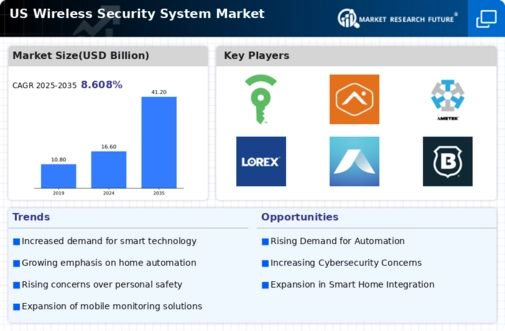Rising Concerns Over Home Security
The wireless security-system market experiences a notable surge in demand due to increasing concerns regarding home security. As crime rates fluctuate, homeowners are becoming more vigilant about protecting their properties. In 2025, approximately 73% of households in the US express a desire for enhanced security measures, indicating a strong market potential. This heightened awareness drives consumers to invest in advanced wireless security systems that offer real-time monitoring and alerts. The integration of features like motion detection and remote access appeals to tech-savvy individuals. Consequently, the wireless security-system market is poised for growth as consumers prioritize safety and security in their homes.
Growing Popularity of Remote Monitoring
The wireless security-system market benefits from the increasing popularity of remote monitoring solutions. With the proliferation of smartphones and mobile applications, consumers can now monitor their properties from virtually anywhere. In 2025, around 60% of users report utilizing mobile apps to manage their security systems, reflecting a shift towards convenience and accessibility. This trend is particularly appealing to busy professionals and frequent travelers who require peace of mind while away from home. As remote monitoring becomes a standard feature in wireless security systems, the market is expected to grow, driven by consumer preferences for flexibility and control over their security measures.
Regulatory Support for Security Standards
Regulatory frameworks and standards significantly influence the wireless security-system market. In the US, government initiatives aimed at enhancing public safety encourage the adoption of advanced security technologies. For instance, the implementation of stricter building codes and safety regulations promotes the installation of wireless security systems in residential and commercial properties. In 2025, approximately 40% of new constructions incorporate integrated security solutions, reflecting a growing trend towards compliance with safety standards. This regulatory support not only boosts consumer confidence but also drives market growth as businesses and homeowners seek to adhere to legal requirements while ensuring their safety.
Increased Investment in Smart City Initiatives
The wireless security-system market is positively impacted by the rising investment in smart city initiatives across the US. As urban areas evolve, municipalities are increasingly adopting advanced security technologies to enhance public safety. In 2025, it is estimated that cities allocate over $2 billion towards smart security solutions, including wireless systems. This investment fosters collaboration between local governments and technology providers, leading to the development of integrated security networks. As cities prioritize safety and efficiency, the wireless security-system market is likely to expand, driven by the demand for innovative solutions that address urban security challenges.
Technological Advancements in Security Solutions
Technological innovations play a pivotal role in shaping the wireless security-system market. The advent of artificial intelligence and machine learning has led to the development of smarter security solutions that can analyze patterns and detect anomalies. In 2025, the market witnesses a 25% increase in the adoption of AI-driven security systems, as they provide enhanced surveillance capabilities. Additionally, advancements in camera technology, such as high-definition video and night vision, contribute to the appeal of wireless systems. As consumers seek cutting-edge solutions, the wireless security-system market is likely to expand, driven by the demand for sophisticated and reliable security technologies.























Leave a Comment